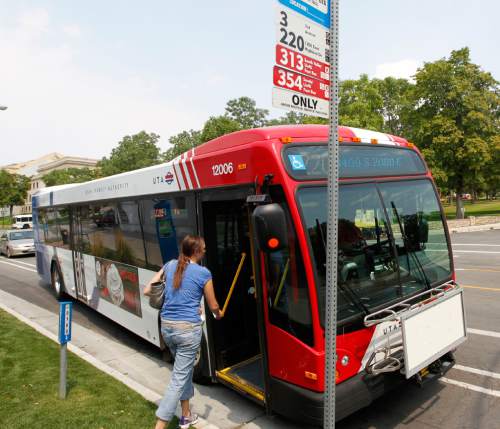This is an archived article that was published on sltrib.com in 2015, and information in the article may be outdated. It is provided only for personal research purposes and may not be reprinted.
If a proposed sales-tax hike for transportation passes, the Utah Transit Authority could increase its revenues by 13 percent — or $39 million a year. But UTA leaders stressed Wednesday they will not, and cannot by law, campaign for that ballot issue.
But they said they can offer education about its benefits, and then outlined how the extra funding could improve the transit system.
"We're just not in a position to be advocates," UTA President and CEO Michael Allegra told the UTA Board before announcing his retirement later in the day.
Voters in eight counties so far — with possibly more coming on board later — will decide Nov. 3 whether to raise sales taxes by a penny for every $4 in sales. In counties where UTA offers transit, 40 percent of the extra revenue would go to transit, and the rest to cities and counties for roads.
"We've instructed our staff that it is appropriate for UTA staff and employees to provide information to both proponents and opponents of this measure and to answer questions, but we don't advocate," said Dave Kallas, senior adviser to Allegra.
"So we won't be out campaigning for this. But we want to have information available for the public," he said.
UTA executives then outlined for the board what they said they have been telling mayors, county leaders and others about how they might spend the money, although Kallas said, "nothing is set in stone."
UTA Chief Planning Officer Matt Sibul said UTA would use the money to have more frequent bus service in more areas and offer more weekend service. Also, the agency hopes to add more shelters at bus stops and expand services such as regional bike sharing and other means to help people reach transit stops.
UTA is aiming to expand bus service by 15 to 20 percent by 2020, Sibul said, and by 40 to 50 percent by 2026. It wants to quadruple the number of bus routes that run after 8 p.m. It wants to increase service on the most important core routes by 30 percent.
And it aims to provide 20 percent more TRAX service to Salt Lake City International Airport.
Sibul said current plans would improve services for 89 percent of all residents within the UTA district. In Salt Lake County, the agency would improve service to 70 percent of low-income people, 68 percent of minorities and 78 percent of households without cars.
Changes planned could improve air quality by removing 2.3 million car trips from the road each year, Sibul said.
Evelyn Everton, Utah director for the conservative Americans for Prosperity, which opposes the tax increase, was not impressed by the agency's outline of intentions.
"We look forward to the UTA spelling out exactly where taxpayers' money will be spent," she said. "If their past is anything like the future, we know this money will not be spent on bus service, but instead will be spent on lavish trips and five-figure bonuses to top executives. I trust that voters will see through their rhetoric and reject further funding for waste, fraud and abuse."
Salt Lake and Box Elder counties are the only two of six counties in the UTA district that have put the tax hike on the ballot so far. Others that have approved the hike for city and county road improvements include the rural counties of Beaver, Grand, Juab, Morgan, San Juan and Uintah.
More counties are expected to follow suit.



